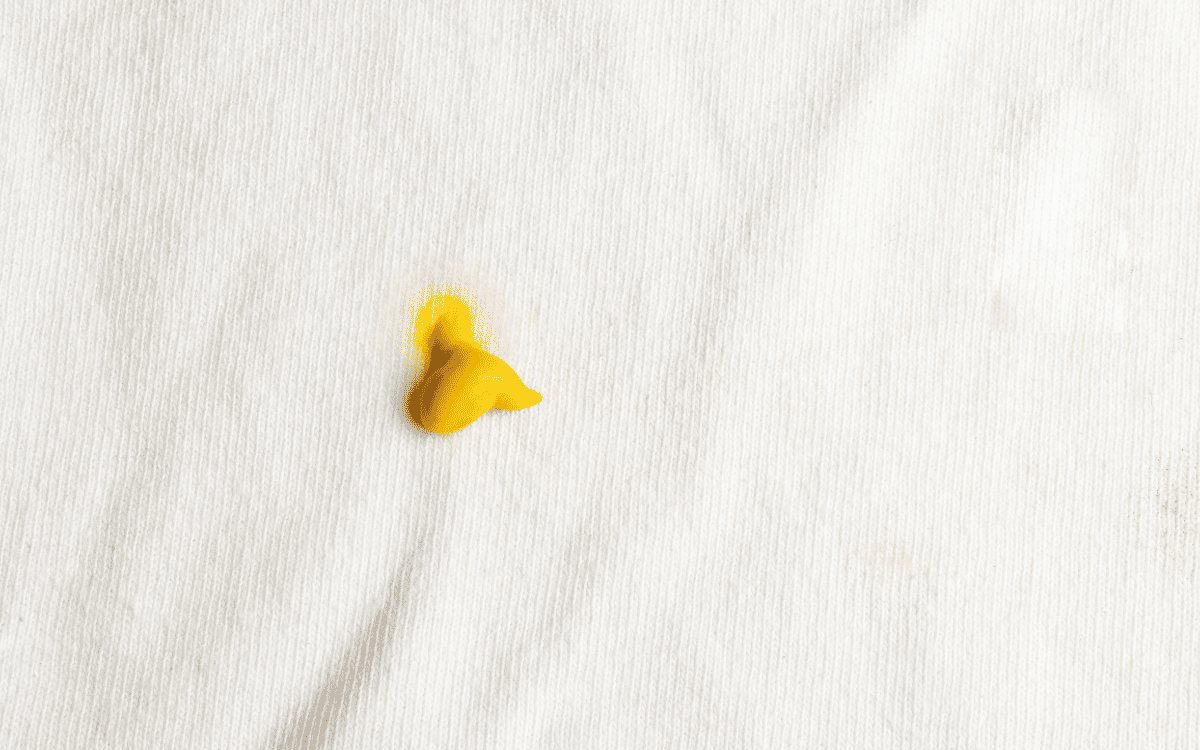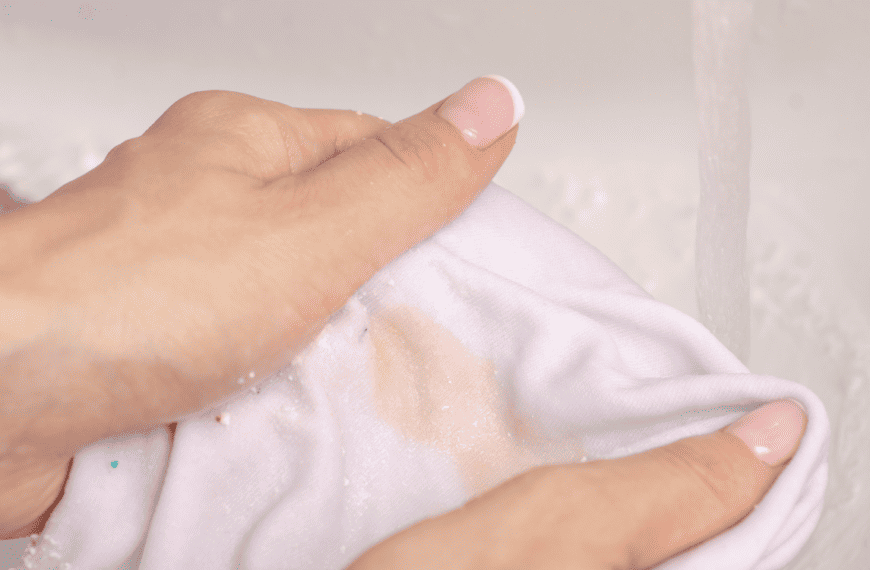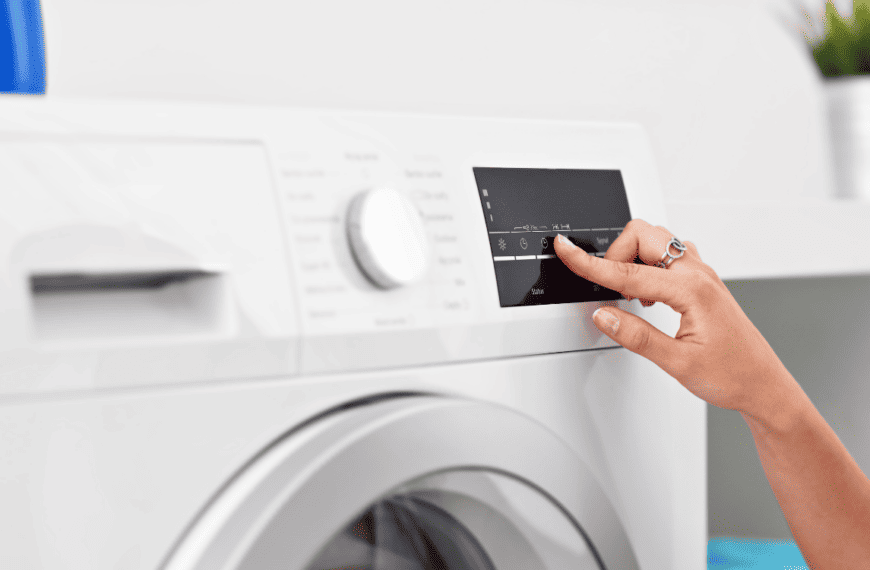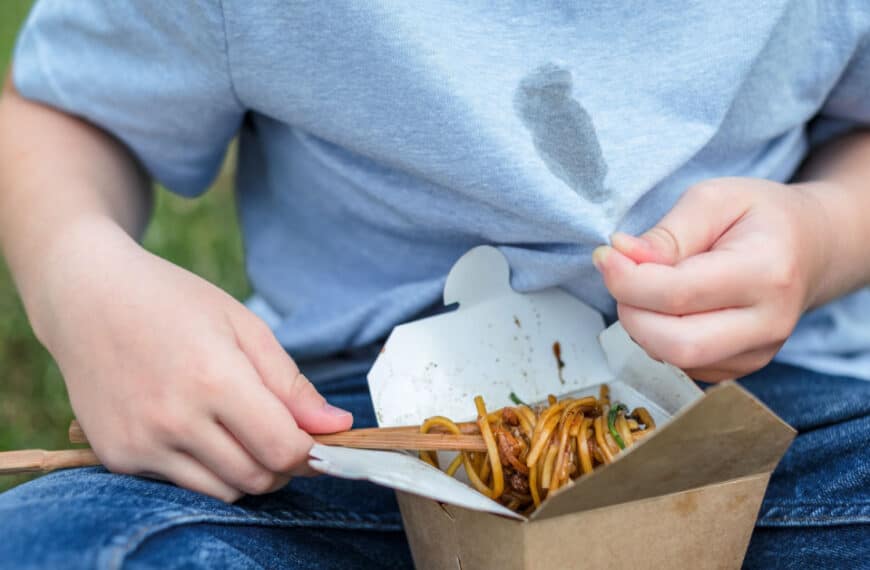Whether it’s excess mustard on a hot dog or you opted for one of those big pretzels at the ball game, mustard has a way of working itself onto our clothing. Mustard has that glaring bright yellow look to it, and although your first thought may be laundry stain remover, I’ll show you how to get a mustard stain out and the steps you can take to ensure you aren’t living with a permanent mustard stain.
Important Tips Before You Begin
I know the first thing you probably want to clarify is: do mustard stains come out? Mustard stains come out of clothing, but it’s easiest to work with fresh mustard stains and to complete this process as quickly as possible.
Here are a few things to know before trying to remove mustard stains.
- Don’t rub mustard stains; they will spread and sink deeper into the fabric surface
- Use a butter knife to scrape off excess mustard on any surface; removing the top layer can leave you less mustard to remove
- Mustard has something called curcuminoids as one of its main ingredients that help it have that bright yellow color and look appetizing on your food, but the pigments will sink into the fibers in your clothing
Skip Ahead:
Removing Mustard Stains From Washable Fabric
Removing Mustard Stains From Non-Washable Fabric
Getting Dried Mustard Stains Out
Remove Mustard Stains From Carpet and Upholstery
Supplies and Tools Needed
Here are the tools and supplies needed to remove fresh mustard stains from washable fabric.
- Spoon
- Cold water
- Dish soap
- Microfiber cloth
- Washing machine
How To Remove Fresh Mustard Stains From Washable Fabric
If you have a fresh mustard stain on washable fabric, you will start by using a spoon to remove any excess mustard. Once you have the majority of mustard removed, rinse the stain thoroughly with cold water. Take a small amount of liquid dish soap and place it directly on the mustard stains. The surfactants in the dish soap will break down the pigments in the mustard; rub the dish soap into the stain with your fingers. Place the washable fabric in the washing machine on a cold cycle. Check to make sure the mustard stains are removed from the clothes before putting in the dryer.
Alternative Methods for Removing Mustard Stains From Washable Fabrics
If dish soap does not work to remove your mustard stains, there are other methods that you may want to consider for washable fabrics.
Baking Soda
Baking soda is alkaline in nature, which allows it to neutralize the pH in the mustard stain. Baking soda also works as a natural scrubber to break up the mustard that has soaked into the fibers.
- Use a dull knife to remove any excess mustard on your fabric
- Create a paste with one tablespoon of baking soda and one tablespoon of water, and pour the solution directly on the mustard stain
- Use a clean microfiber cloth or your fingers to rub the baking soda into the stain
- Rinse baking soda out completely
- Put through a cold wash cycle to remove the rest of the stains from the fabric if necessary; repeat the baking soda solution before putting the fabrics in the dryer
Liquid Laundry Detergent
Liquid laundry detergent can work very much like liquid dish soap, with the surfactants lifting the mustard stains from clothes and breaking them down. Using concentrated liquid laundry detergent as a way to pre-treat mustard stains is highly effective.
- Use a knife or spoon to get the mustard that is on the fabric removed before treating
- Turn the fabric inside out and rinse with cold water from the backside to push excess mustard stains out
- Take a teaspoon of liquid laundry detergent and place the cleaning solution directly on the mustard stain
- Allow the detergent to sit for 20 minutes before rubbing it in and then putting it in the washing machine for a cold wash
- There is no need to rinse the fabric again before the wash; a little extra liquid laundry detergent won’t hurt as it goes through a wash cycle
- Check the stained area when the wash is complete and ensure that it is completely removed
Oxygenated Bleach
The oxygen molecules in oxygenated bleach help to remove mustard stains and lighten their pigment.
- Fill a tub, sink, or bowl full of water and add a scoop of OxiClean Versatile Stain Remover
- Completely submerge the clothing in the cleaning solution and let it sit for at least a half hour
- Use a soft-bristled brush to lightly scrub the area where the mustard stain persists
- Place in the washing machine on a cold wash cycle
- Add more OxiClean if you need to treat the stain further; you can put the color safe oxygenated bleach directly on the stain and send it in the wash for round two
Instant Stain Remover
For on the go stain treatment, a Tide To Go instant stain remover stick is a great solution. I’ll warn you that this may not take the stain out fully. You may still need to wash the fabric when you get home, but this helps you get through the day without being a mess.
- Use a dull knife or spoon to get as much mustard off of the clothing as possible
- Blot the stain with a few drops of cool water on a clean cloth
- Apply the Tide To Go stain remover directly to the stain and then blot with an absorbent white cloth
- When you are able to remove the clothing and wash the mustard stain, be sure to rinse it with cold water first
- Place the clothing in the washing machine for a cold wash and only dry if the solution worked to get mustard completely out of the garment
Hydrogen Peroxide
Hydrogen peroxide works as a mild bleach and oxidizer to lighten and remove mustard stains. I know I’ve already mentioned that you should test cleaning methods in an inconspicuous area of your clothing, but with hydrogen peroxide, it’s a must if you don’t want to lose color in the fabric.
- Remove all excess mustard from the stained area with a spoon
- Take a rag and dip the corner of it in 3% hydrogen peroxide
- Blot the stain with the hydrogen peroxide soaked rag for 10 to 15 minutes and then rinse with cold water
- Apply a little liquid dish soap to the stained area and then place in the washing machine for a cold wash
- When finished in the washing machine, check to see if the stain is removed, repeat the process if necessary
Cleaning Methods for Non-Washable Fabrics
One of the most common non-washable fabrics you can run across when it comes to mustard stains is neckties. Neckties typically need dry cleaning and professional treatment when they are stained; here is the method I use with stubborn stains on non-washable fabrics.
- Remove as much of the mustard as you can from the non-washable fabric
- Take a damp cloth, add a little dish soap to the cloth, ensure the cloth is not soaking wet
- Blot the mustard stain with the wet cloth for about five minutes
- Blot the mustard stain with a dry cloth to soak up any of the water
- Allow to air dry; if stain persists, consider taking the non-washable fabric to the dry cleaner and alert them to the stain
How Do You Get Dried Mustard Stains Out?
The best defense you have when removing mustard stains is to act as quickly as possible. If a mustard stain got by you and now you are left with a dried mustard stain, the process takes a bit more time. However, vinegar can help. Vinegar is acidic and will help to neutralize the pigment in the yellow mustard.
- Rinse the dried mustard stain with cold water to see if any of it will still come out
- Create a solution with equal parts vinegar and equal parts water
- Use a cloth, dip it in the water, and then blot the stain with this rag
- After blotting for about ten minutes, put a little laundry detergent directly on the stain
- Wash the fabric in a washing machine on cold and check to see if the stain is removed before putting it in the dryer
- If dried mustard stain still persists, repeat the process again from the top
Best Way To Remove Mustard From Carpet and Upholstery
If you managed to dodge the mustard coming out of your turkey sandwich and instead you are dealing with a carpet or upholstery stain, you can treat it with Simple Solution Extreme Pet Stain and Odor Remover. I know you think this is a carpet treatment for pet stains, but it’s an enzyme cleaner that does a tremendous job on mustard.
- Pull up as much of the mustard spill as you can using a spoon or a knife
- Spot-check the Simple Solution Extreme Pet Stain and Odor Remover in an inconspicuous location to make sure it does not discolor the carpet or upholstery
- Spray the Simple Solution Extreme Pet Stain and Odor Remover directly on the stain
- Let the stain remover sit on the carpet or upholstery for several minutes, and then blot it with a damp cloth
- Wait for the area to dry, and then vacuum the carpet or upholstery
- Repeat the process if the stain persists
Why Does Mustard Stain?
The yellow mustard seeds are the real culprit when it comes to mustard stains. Those seeds contain curcumin. The color molecules in the curcumin give mustard the yellow color, but they also sink into the fibers of your clothing and create deep stains. Curcumin is known to also be water repellent, making it all that much more difficult to lift the stains off of your clothing.
Is Mustard a Permanent Stain?
Mustard can be a permanent stain if it is not treated as soon as it occurs. The pigment in the mustard will attach to the fabric of the fibers and become very difficult to remove. Continuing to work with liquid laundry detergent, vinegar, cold water, and dish soap can eventually loosen the stain and start to release it.
Frequently Asked Questions (FAQ)
What if the Stain Doesn’t Come Out After Multiple Treatments?
If the mustard stain does not come out after multiple treatments, bring it to a local seamstress or laundry service to see if they have additional methods and alternatives that they may be able to try.
Is It Safe To Use Multiple Stain Removal Methods One After the Other?
When removing mustard stains from clothing, you can use something like dish soap and then treat it with laundry detergent. Make sure that the stain removal methods do not have ingredients that will interact with each other negatively. For example, hydrogen peroxide and vinegar can create peracetic acid, which is potentially harmful. Always spot treat an area that is less visible.









